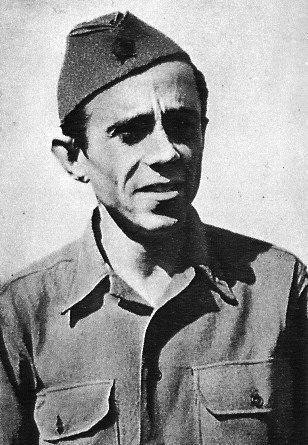Name Nako Spiru | Role Politician | |
 | ||
Died November 20, 1947, Tirana, Albania | ||
Nako Spiru (4 January 1918 in Durrës – 20 November 1947 in Tirana) was an Albanian politician and high-ranking official of the Communist Party of Albania (PKSh).

Life
Spiru came from a Orthodox family from the Adriatic port of Durrës. He studied in the Italian Commercial College of Corfu and later economics in University of Turin. After the Italian invasion of Albania in 1939, he went as joined the resistance and served as the right hand of Enver Hoxha in the National Liberation Movement. In 1941, he became member of the newly founded Communist Party of Albania. After the assassination of Qemal Stafa, he came in charge of the Youth section of the Party.
After the end of World War II, Spiru was elected to lead the "State Planning Commission", the highest entity in the economical sphere in Albania. Soon he would become one of the victims of the factional war inside the Party: on one hand, the so-called "intellectuals" or "moderate" led by Mehmet Shehu and Sejfulla Maleshova, on the other hand the so-called "workers" under the leadership of Koçi Xoxe, Deputy Prime Minister and Minister of Interior, also head of the State Security Service Sigurimi. They first pushed towards relationship with the Soviet Union, then later with Yugoslavia.
Spiru opposed Xoxe's friendship and economic agreement of July 1946, which imposed a merger of the economies of Albania and Yugoslavia, with the ultimate goal the integration of Albania into the Yugoslav Federation as one of the republics. Communist Party General Secretary and Prime Minister Enver Hoxha feared a switch controlled by Tito on the Albanian Communist Party, and took the side of Xoxe's faction. In April 1947, Spiru led new negotiations in Belgrade, where he asked for the conclusion of a revised trade agreement and increased economic aid. The Yugoslavs refused and called instead for the immediate coordination of the economic plans of both states. With the backing of Hoxha, Spiru refused. Instead Hoxha and Spiru flew in July 1947 to Moscow and concluded a trade agreement with the Soviet Union, which guaranteed to Albania safe-ground for the refusal of the Yugoslavian support.
Supported by Tito, Xoxe began a smear campaign against Spiru. In November 1947, Xoxe accused him at a meeting of the Central Committee for "anti-Party, nationalist activity". The next day he was found shot in his apartment. One first published illustration for he killed himself accidentally while handling his gun, a second official announcement declared the death as suicide from "remorse over his betrayal". After the demise of Xoxe for being a "spy" and "Titoist", things changed. Spiru's figure was rehabilitated and it was said "to have been murdered by the Sigurimi on behalf Xoxe, or been forced to suicide". Spiru was married to Liri Belishova, herself a member of the Politburo of the Party of Labour of Albania who would be expelled and persecuted later. In 1991, Belishova gave her version of the story: she alleged that "Enver Hoxha was behind everything and he had killed her husband".
